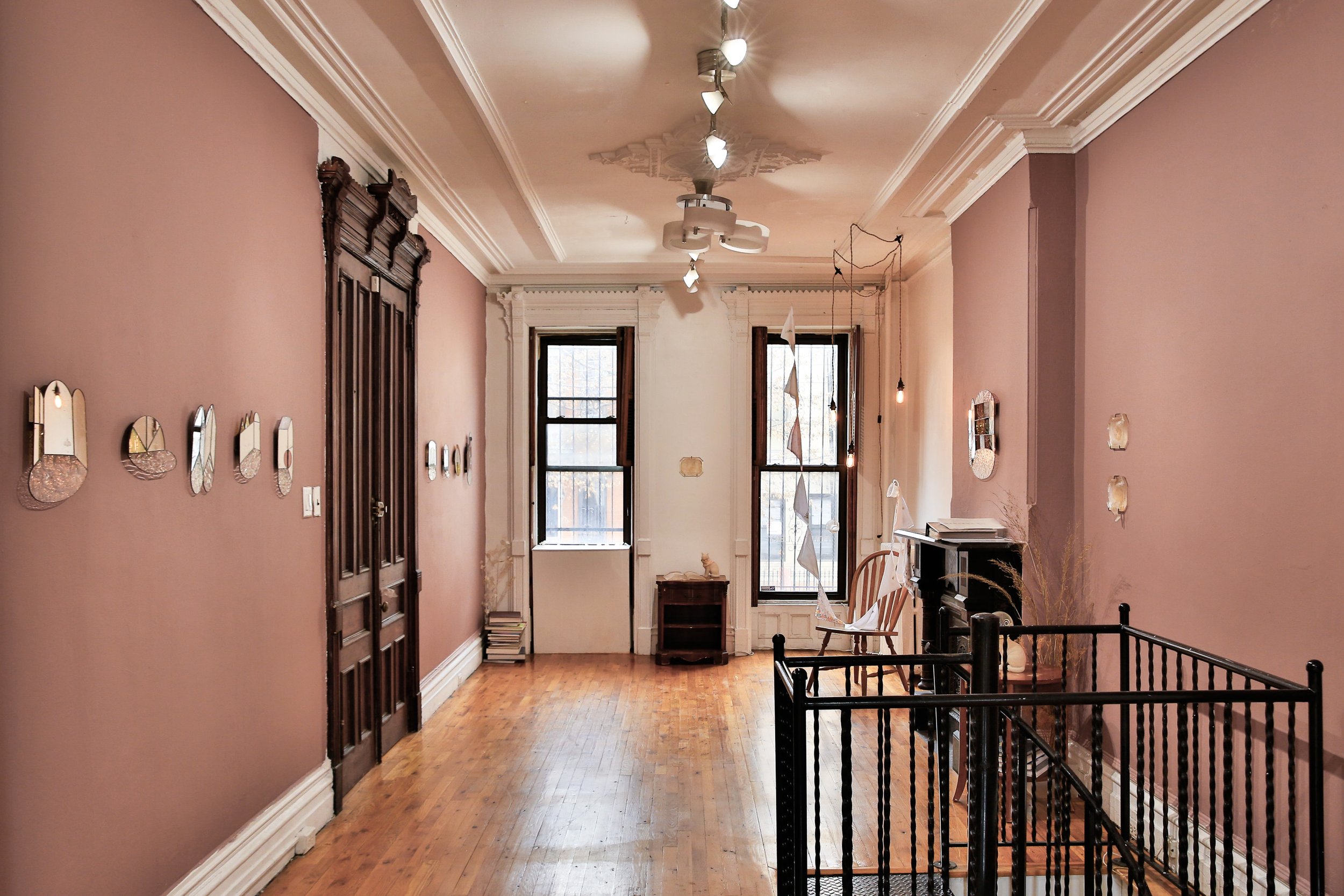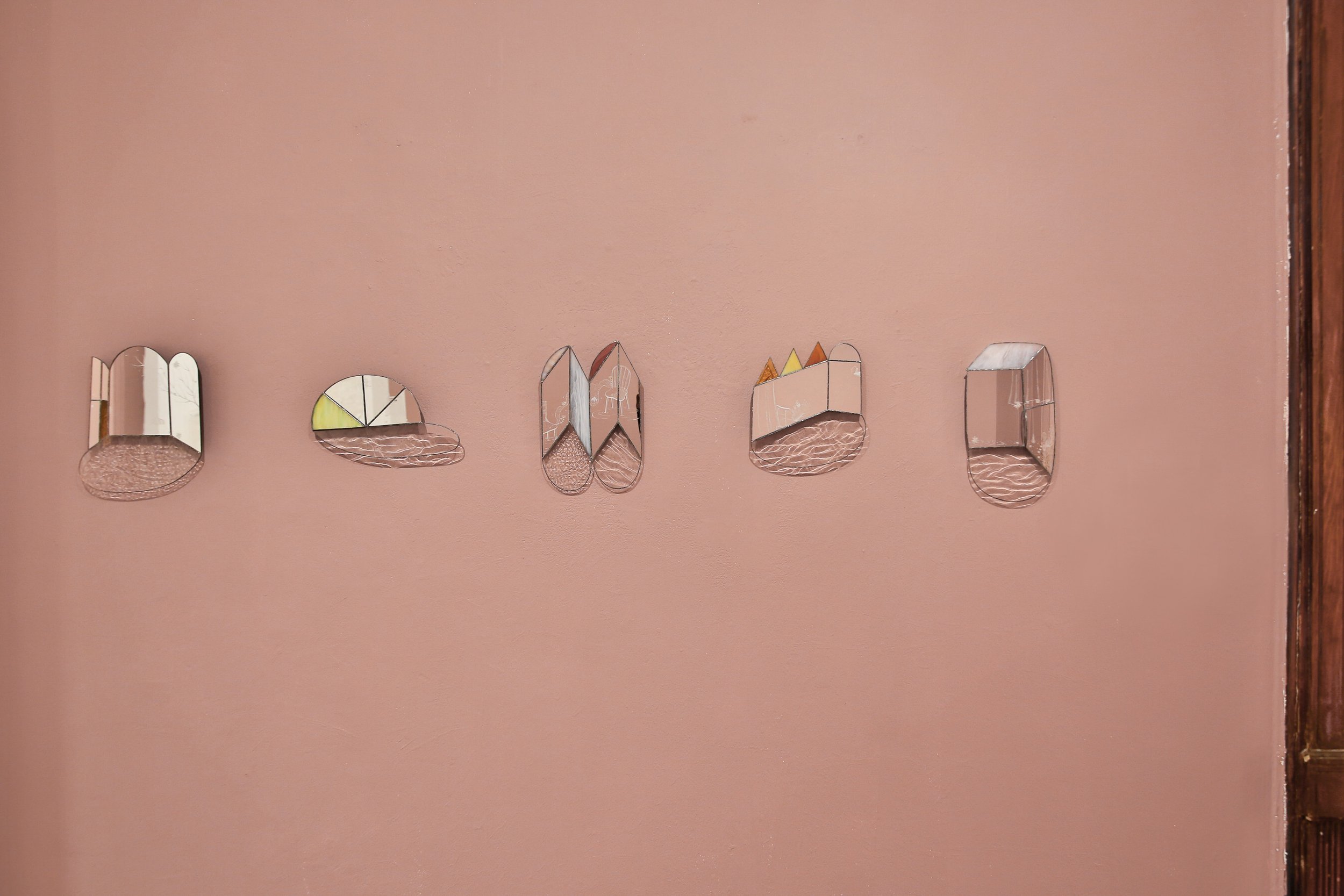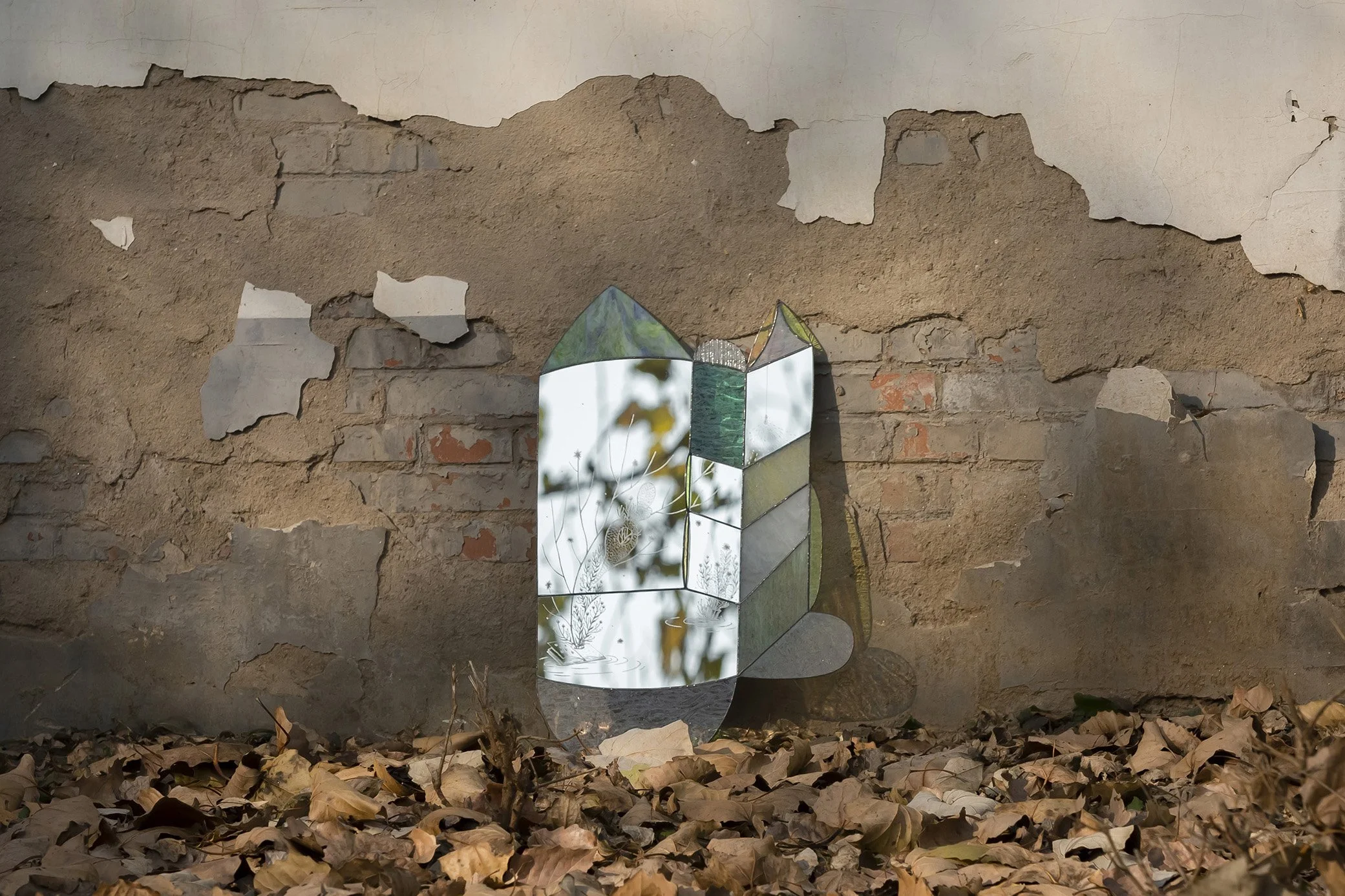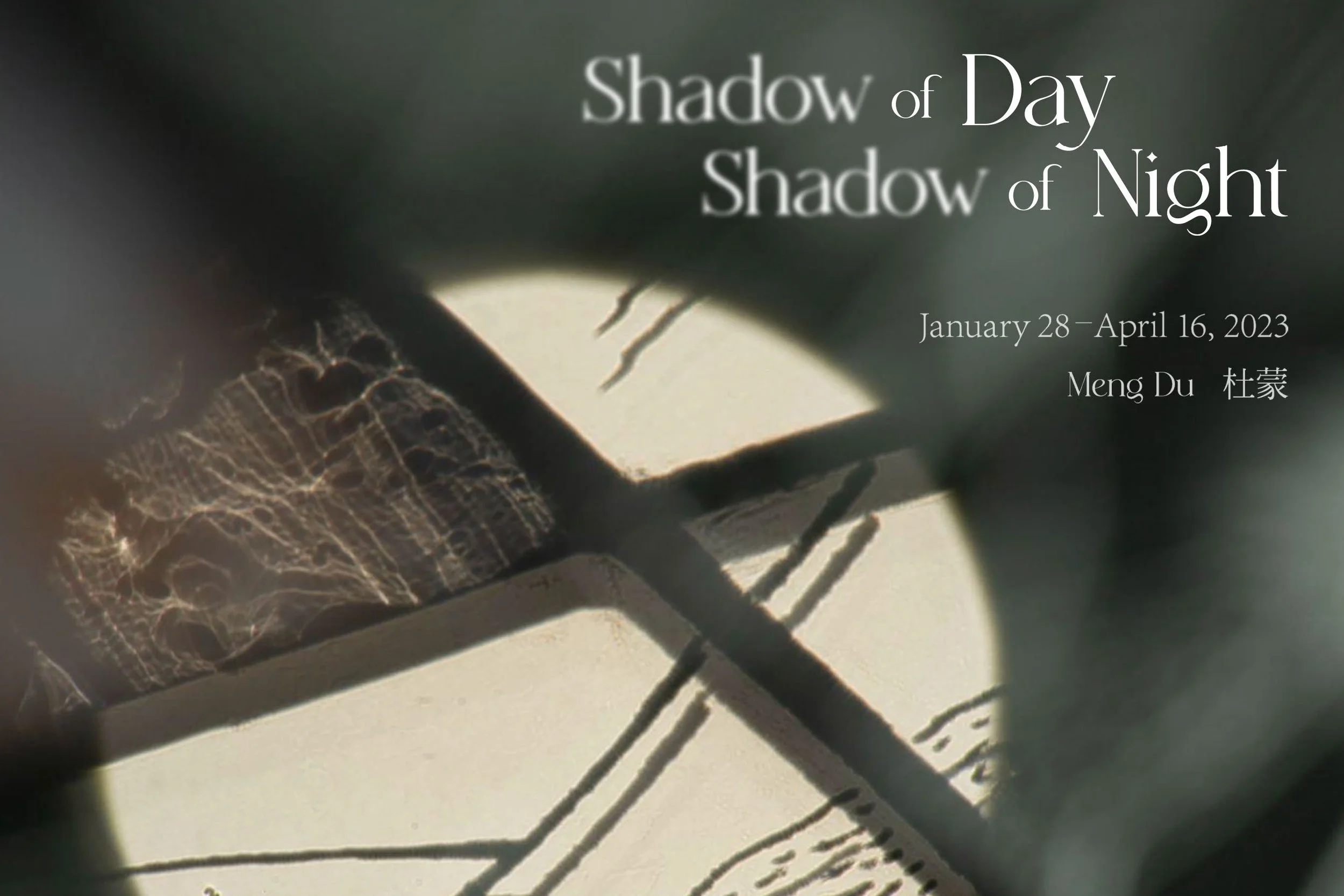Meng Du, Grow Secretly in A Boundless World No.01, 2022. Glass, mirror, copper foil, 16.2 x 25 x 0.8 inches ©Meng Du, photo by Jingxin Hu, courtesy of Fou Gallery
Solo Exhibition
Shadow of Day,
Shadow of Night



















Shadow of Day, Shadow of Night
Artist: Meng Du
January 28–April 16, 2023
Curator: Lynn Hai
This exhibit showcases the collection of Meng Du's glass sculptures which includes pieces created using the cast, blown, and Tiffany techniques during the time period of 2020-2022. The exhibition curator, Lynn Hai, aims to highlight the intricate narrative and literary elements present in Du's glass artwork. This effort is reflected in the exhibition's curatorial writing and the visual and spatial presentation, which strive to enhance and accentuate the poetic "constellation" structure implicit in the narratives conveyed through Du's creations.
Du's glass sculptures represent a tangible reflection of spontaneous narrativity in visual art. Her approach to art emphasizes the preservation of personal recollections and experiences, avoiding their conventional fading and receding. Additionally, she pays considerable attention to exploring the complex link between memory and context through time and space.
The exhibition features six series of works, namely, People Sitting by the Window & Grow Secretly in A Boundless World; Drift Through the Forest, Silence In the Valley; Hello, Again; Apartment; A Cat See the World Leaping Away; Cat in the Corner.
The flat sculptures, People Sitting by the Window, are composed of small panels of sheet glass and mirrors collaged using the Tiffany glass technique, complemented by delicate hand-engraved drawings on some of the mirror surfaces. The artwork's imagery reflects the windows we encounter in our daily lives, revealing mundane worlds and the restless cycles of seasons. These works share a unique atmosphere with the night city, depicted as tiny lights in the writings of the Chinese author Wang Anyi, who wrote, "The world is embedded in some sporadic corners of the city ……that beauty is just like fireflies, ephemeral and glimmery. But these shines are already the utmost struggles of those free spirits."
Du's works employ a visual language where glass pieces are assembled to create imagery depicting windows. The mirrors, reflecting ever-changing surroundings at every moment, contribute to the narrative structure of the works. The slender lines on the mirrors illustrate meaningful objects that elicit memories. Moreover, the different colors, such as cold green or warm red, convey varying emotions, culminating in a unique narrative structure of People Sitting by the Window.
The exhibition showcases an installation titled Apartment - A Pair of Cups No.2 - Apt 410, which features tea-dyed translucent glass cups suspended above an old wooden chair, encircled by pendant lights and floating handkerchiefs. Another rendition of this work, Apartment - A Pair of Cups No.2 - Apt 685, is also being concurrently displayed at the Shanghai Museum of Glass. The titles of this series pay homage to the apartment numbers of the exhibiting venues. Through the use of light and shadow, Du's glass sculptures immortalize the essence of old and overlooked objects that we encounter in our daily routines. These objects, scattered across different times and places, weave together narratives of interconnected moments. Du's masterful deployment of a visually rich language evokes a strong sense of nostalgia, underscoring her works with a pervasive atmosphere of antiquity.
French philosopher Henri Bergson (1859-1941) posited a distinction between two facets of time. On one hand, he referred to "objective time," the time discerned through common sense; and on the other, "la durée (duration)," or "lived time," referring to the inner subjective experience of time. According to Bergson, only "lived time" accurately encapsulates the "real" time felt, lived, and acted, vividly describing the interpenetration of moments and articulating the intensity of consciousness. Bergson maintained that as we delve deeper into our consciousness, the concept of "objective time" holds less relevance. Storytellers, such as writers and artists, often focus on and manipulate "lived time," expanding a few minutes into a vast volume of content or compressing an extended period into a brief sketch.
Du's series of ten works, titled "Drifting through the Forest, Silence in the Valley," are akin to ten segments of her "lived time." After many years of working intimately with glass as a creative medium, the artist has developed a tender empathy and self-projection towards the material's qualities. Du feels that she "can see herself in the glass bottles that can be found everywhere in life." Consequently, the artist collected discarded glass bottles that have ended their functional life to create Drifting through the Forest, Silence in the Valley, anticipating their journeys to continue forward. In this group of works, the order and time of creation are immaterial; what is essential is the context in which each piece was created, such as the empty wine bottles cluttering the corner of Du's friend's house during material selection or the hazy, pale sunlight creeping into the window pane on an efficient afternoon. From the vantage point of "objective time," a scene may only last a few seconds, but in terms of "lived time," the experience is replete with the flow of consciousness, interspersed with recollections, imaginations, and emotions, and therefore appears to be significantly weighted. Objective external events are colored by our reflection and become distinct as the inner realities, while seemingly simple events can be perceived and experienced in subjectively intricate ways.
Upon observing several works by Du concurrently, one may discern that these fragmented narratives coalesce into a cohesive structure with implicit interconnections. This narrative style found in Du's works bears resemblance to the “constellation” style of narrative, as expounded by the 2018 Nobel Prize winner, the Polish author Olga Tokarczuk, in her celebrated book Flights. Rather than employing a linear passage of time as the guiding principle for the plot, this narrative approach weakens the significance of the sequence of events and disrupts their order to create a narrative connection from other aspects of the events. For instance, narratives linked by space, characters, and elements of the event can be placed in adjacent chapters, but the chapters are not chronological. In the words of Tokarczuk, “Constellation, not sequencing, carries truth.”
The exhibition, Shadow of Day, Shadow of Night, endeavors to refine and highlight this “constellation” narrative structure in Du's works to a striking and compelling level through a visual presentation that can only be accomplished in a physical space. Instead of arranging the works sequentially, the exhibition aims to uncover the latent bonds and resonances between the works and their creative narratives. The show weaves stories together and sparks conversations, immersing the viewer in a constellation of stories, detached from the laws of advancing time. "There is no beginning and no end, just a constant change of new forms, from formation to decomposition, from decomposition to formation, from birth to extinction, from extinction to birth, ad infinitum." The spatial atmosphere of the exhibition is akin to a cryptic private room, with antique furniture and books serving as the display pedestals for the artworks. The lighting is dim, and the details are perceptible as hints of the presence of stories and memories. Quietly, books are strewn wordlessly on the old desk, the sunset filtering through the dappled and transparent thick glass, and cats peering surreptitiously from inconspicuous corners. Fragments of narratives are scattered all over the room, and the room stands silently amidst the alternation of day and night.
Entering the exhibition and reading the stories is akin to embarking on a journey where one can freely navigate time and space. The piecemeal information and disordered events may implicitly coincide with the way people comprehend things in this era: we all exist in separate consciousness and distinct moments, and often necessitate abstract thinking to reconstruct narratives. Shadow of Day, Shadow of Night strives to provoke the obscure connections between seemingly fragmented things and establish a constellation that progressively "carries truth."
Text / Lynn Hai
Exhibition Catalogue
News and Reviews
“Meng Du Takes Over Fou Gallery with Her New Body of Glass Works.” Widewalls, 2023.4.3 [Link>>] [View PDF >>]
“Chinese artist, Meng Du writes evocatively about the concept behind 'A Pair of Glasses in the Kitchen,'” International Festival of Glass, 2023.2.10 [Link >>]
“Art Show | Fou Gallery Presents Artist Meng Du’s Solo Show: Shadow of Day, Shadow of Night.” Li Tang, 2023.2.6 [Link>>] [View PDF >>]
“Fou Gallery presents "Shadow of Day, Shadow of Night" featuring Meng Du's latest work.” CAFA Art Info, 2023.1.30 [Link>>] [View PDF >>]
“杜蒙:我从未“征服”玻璃”,Tatler Air ,2023.3.29 [Link>>] [View PDF >>]
Artist - Meng Du
b.1986, Beijing, China
Meng Du graduated from the Graphic Design program of Central Academy of Fine Arts, Beijing (B.F.A.) in 2008 and the Digital Art program at the Department of Glass Program of Rochester Institute of Technology (M.F.A.) in 2013. Currently, she is living and working in Beijing. Her work has continued to exhibit in China, Europe, and in the United States. Her recent exhibitions include: My Flower Doesn't Have A Name Yet, Shanghai Museum of Glass, Shanghai (2023); Meng Du: Echo from the Highland II, Genesis Foundation, Beijing (2022); Finding Hidden Genius: Vivian Maier, Today Art Museum, Beijing (2021); Blazing Element, An+ Art & Design Center, Shenzhen (2020); Mind the Gap, The Delaware Contemporary, U.S.A. (2020); Meng Du: Embers, Fou Gallery, New York (2019); Meng Du: The Room, Shanghai Museum of Glass, Shanghai (2018) and The International Exhibition of Glass Kanazawa at Shiinoki Cultural Complex, Ishikawa Prefecture, Japan (2016). In June 2016, she had her first solo exhibition in New York: Meng Du: The Climb, The Fall at Fou Gallery, New York (2016). She served as a residency artist at Seto International Ceramic & Glass Art Exchange Program, Seto, Japan (2021) and Aichi University of Education Glass Program, Aichi, Japan (2017). Her work has been widely featured in China Daily, People’s Daily, Cosmopolitan, Vogue, Yitiao, Art China, CAFA Art Info, and other media platforms. She was invited to give lectures at YiXi (2020) and ROG International Art Project Online Symposium (2020). In 2016, she won the Honorable Mention for The International Exhibition of Glass Kanazawa (Kanazawa, Japan). In 2018, she won the 2018 Saxe Emerging Artist Award at 48th Glass Art Society Conference (Venice, Italy). She is the youngest artist who presented a solo exhibition at the Shanghai Museum of Glass.

